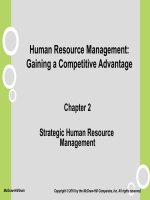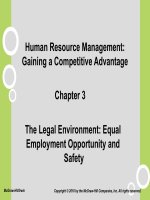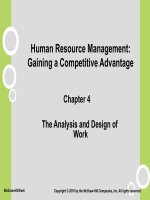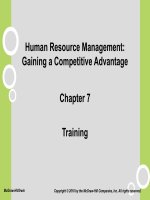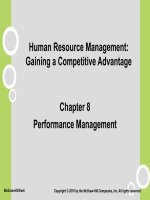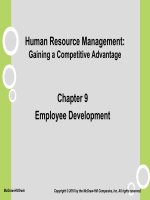Human resource management gaining a competitive advantage 2014 chapter 1
Bạn đang xem bản rút gọn của tài liệu. Xem và tải ngay bản đầy đủ của tài liệu tại đây (460.56 KB, 38 trang )
Human Resource Management:
Gaining a Competitive Advantage
Chapter 01
Human Resource Management:
Gaining a Competitive Advantage
McGraw-Hill/Irwin
Copyright © 2013 by The McGraw-Hill Companies, Inc. All rights reserved.
Learning Objectives
Discuss roles and activities of HRM function
Discuss implications of the economy, makeup of the
labor force and ethics for company sustainability
Discuss how HRM affects a balanced scorecard
Discuss what companies should do to compete in
global marketplace
Identify how technology such as social networking is
influencing HRM
Discuss HRM practices that support highperformance work systems
Provide a brief description of HRM practices
1-2
Introduction
Competitiveness – a company’s ability to
maintain and gain market share.
Human resource management (HRM) – the
policies, practices, and systems that influence
employees’ behavior, attitudes and
performance.
1-3
HRM Practices
1-4
Responsibilities of HR Departments
1. Employment and Recruiting
2. Training and Development
3. Compensation
4. Benefits
5. Employee Services
6. Employee and Community Relations
7. Personnel Records
8. Health and Safety
9. Strategic Planning
1-5
HR as a Business with 3 Product Lines
Business
Partner
Services
Strategic Partner
Human
Resources
1-6
6 HR Competencies
1-7
Strategic Role of the HRM Function
Time spent on administrative tasks is decreasing.
HR roles as a strategic business partner, change
agent and employee advocate are increasing.
HR is challenged to shift focus from current
operations to future strategies and prepare non-HR
managers to develop and implement HR practices.
This shift presents two challenges:
Self-service
Outsourcing
1-8
Shared Service Model
Shared Service Model is a way to organize
the HR function that includes centers of
expertise or excellence, service centers
and business partners to help control costs
and improve business-relevance and
timeliness of HR practices.
1-9
HR Playing a Strategic Role
in the Business?
1. What is HR doing to provide value-added
services to internal clients?
2. What can HR add to the bottom line?
3. How are you measuring HR effectiveness?
4. How can we reinvest in employees?
1-10
Questions, cont.
5. What HR strategy will get the business
from point A to point B?
6. What makes an employee want to stay?
7. How will we invest in HR for a better HR
department than competitors have?
8. What should we be doing to improve our
marketplace position?
9. What’s the best change to prepare for the
future?
1-11
How is the HRM Function Changing?
As part of its strategic role, HR can engage
in evidence-based HR.
Evidence-based HR – demonstrating that
HR practices have a positive influence on
the company’s bottom line or key
stakeholders.
1-12
The HRM Profession
HR salaries vary according to position,
experience, education, training, location and
firm size.
The primary professional organization for
HRM is the Society for Human Resource
Management (SHRM) (www.shrm.org)
1-13
3 Competitive Challenges
Influencing HRM
Technology
Sustainability
1-14
The Sustainability Challenge
Sustainability is the ability of a company to
survive and succeed in a dynamic
competitive environment.
Stakeholders include shareholders, the
community, customers and all other parties
that have an interest in seeing that the
company succeeds.
1-15
The Sustainability Challenge
Sustainability includes the ability to:
deliver a return to shareholders
provide high-quality products, services and
work experiences for employees
increase value placed on intangible
assets, human capital and social
responsibility
adapt to changing characteristics and
expectations
of the labor force
address legal and ethical issues
effectively use new work arrangements
1-16
Economy- Implications for HR
Structure of the economy
Development and speed of social media
Growth in professional and service occupations
Skill demands for jobs are changing
Knowledge is becoming more valuable
Intangible assets
Knowledge workers
Empowerment
Learning organization
Social collaboration and social networking
technology
1-17
The Sustainability Challenge
1-18
Common Themes of Employee Engagement
Pride and satisfaction with employer and job
Opportunity to perform challenging work
Recognition and positive feedback from contributions
Personal support from manager
Effort above and beyond the minimum
Understanding link between one’s job and company’s mission
Prospects for future growth with the company
Intention to stay with the company
1-19
Talent Management
Talent management is the systematic planned
strategic effort by a company to use bundles of
HRM practices including acquiring and
assessing employees, learning and
development, performance management , and
compensation to attract, retain, develop, and
motivate highly skilled employees and
managers.
Growth of contingent workers and part-time
employees
1-20
The Balanced Scorecard
The balanced scorecard provides a view
of the company from the perspective of
internal and external customers, employees
and shareholders.
The balanced scorecard should be used
to:
Link HRM activities to the company’s business
strategy.
Evaluate the extent to which HR is helping meet
the company’s strategic objectives.
1-21
The Balanced Scorecard
How do customers see us?
What must we excel at?
Can we continuously improve and create
value?
How do we look to shareholders?
1-22
Customer Service and Quality
Total Quality Management (TQM) Core Values
• Methods and processes are designed to meet
internal and external customers’ needs.
• Every employee receives training in quality.
• Promote cooperation with vendors, suppliers and
customers.
• Managers measure progress with feedback based
on data.
• Quality is designed into a product or service so that
errors are prevented rather than being detected and
corrected.
1-23
Customer Service and Quality
Malcolm Baldrige National Quality Award
ISO 9000:2000
Six Sigma Process
Lean Thinking
1-24
Changing Demographics
Workforce Diversity
Internal labor force - current employees
External labor market - persons outside the
firm actively seeking employment
U.S. workforce is aging rapidly
Increased workforce diversity
Influence of immigration
1-25

